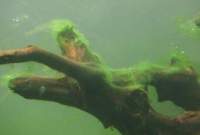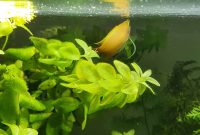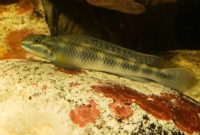On this occasion, we will concentrate speak about Green Spot Algae (GSA). They often emerge up in the planted tank as a bunch of little green dots sticking on the hard surfaces, such as hardscapes, aquarium equipment, substrates, ornaments, and foliage of most aquatic plants that grow slowly.
As much as other freshwater aquarium algae types, they are a nuisance that could be fairly nasty in your aquarium. This is because their capability to form ugly green coats over the fish tank thus makes it unattractive and, in some instances, uncomfortable for aquatic creatures.
In the beginning, you can still tolerate their presence due to the small number, so they do not exist quite annoyed. But, if these algae getting grows out of control, they would cover any aquarium objects; in this case, they do not appear as tiny dots but as green coats over the surfaces.
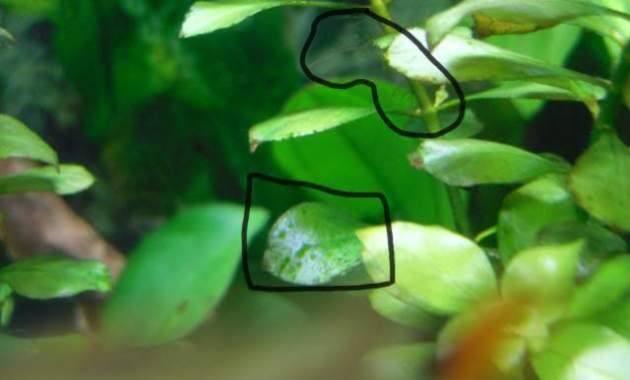
TABLE OF CONTENTS
What Is Green Spot Algae?
Green spot algae (GSA) is a member of the freshwater aquatic green algae family. They belong to coleochaete, which is a genus of parenchymatous charophyte green algae under of Coleochaetales order.
These algae types are able to attach to various surfaces inside the aquarium, such as plants, decorations, equipment, substrate, and even wall glass.
The growth of GSA is pretty swift under favorable conditions; they can be easily established in a hardscape and gradually spread to other nearby objects in the planted aquarium in a few time. Then, cover entirely for several days if you are untreated.
How To Identify Green Spot Algae In Freshwater Aquarium
You can easily identify these algae from their shape. They present as little circulars with bright green in color. They often appear as colonizing of numerous green dots, then grow to creep to the closest objects as the hard and nearly flat stuff. Their texture can be felt when running your fingertips on them.
Generally, they establish some small green spots on the hard surface, such as wood, stones, and tank glass. GSA also frequently develops on the leaves of slow-growing aquatic plants such as bucephalandra and anubias species.
The green spot algae that form on the wall glass usually has a lighter green tint. While those that vegetate on the plants’ leaves naturally arise as green dots.
Their size is tiny, about 1 millimeter (0.004 inches) in diameter. However, when you left them to grow up without any way to control them, they would merge and become a blotchy mat on the object’s surface. Well, at this phase, they may not seem like spots anymore.
Another fact about green spot algae is their growth rates are slow, which is different from most aquarium algae species which typically rapidly multiply themselves.
How does Green Spot Algae Reproduce?
Green spot algae are haploid; they reproduce in two ways by asexual and sexual methods. This alga also has true multicellular organization, with plasmodesmata communicating between adjacent cells.
- Asexual, this reproduction process occurs by the formation of zoospores.
- Sexual, this reproduction method happens by oogamy. Once fertilization is over, the sterile jacket of cells will establish, then surround the zygotes for their protection.
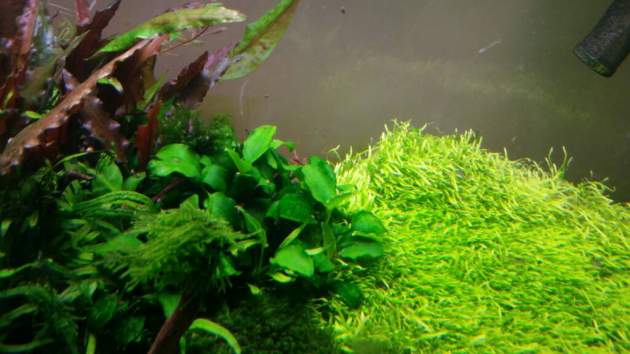
Green Dust Algae VS Green Spot Algae
There is another green alga that is almost similar to green spot algae when present in the aquarium. Green dust algae (GDA) has the ability to form green flatted coats across the surface of aquarium objects, which is identical to green spot algae (GSA).
Both of them typically grow on the leaves and decorations in the fish tank; they will continue to generate themselves, making their population become bigger if the conditions are favorable.
However, when you see their morphological features, they are actually different from each other. As their name suggests, green dust algae arise as dust layers with green color on the wall glass and aquarium objects. In comparison, the green spot algae (GSA) appears as tiny, circular thin green disks on the surfaces.
To differentiate these two green algae types, you can use your fingertips to feel their texture. The green spot algae give a rough or harder sensation on the edge of your finger when touching them, while the green dust algae are relatively smooth and easy to lift off.
The second point about them is GSA are difficult to wipe out from the surfaces; green dust algae can scrub off or erase easily. Nonetheless, if you let them thrive without being cured for an extended period, the GDA may also establish a thick green film that is tough to scrape off.
And the last, the growth rate of green spot algae is slower, unlike the green dust algae, which runs faster.
Generally, green dust algae are caused by abrupt changes in the aquarium, such as fluctuating parameters, too much light intensity, changes in equipment, and adding more pets. Treating GDA is slightly simple: make some water changes and keep the aquarium parameter consistently stable.
What Causes Green Spot Algae In The Freshwater Aquarium?
This freshwater aquarium algae outbreak can be triggered by several factors, including deficiency of carbon dioxide, overlighting, low or too much phosphate level, and high organic waste as well as old damaged leaves. These elements collaborate to push the development of green spot algae in tropical aquariums.
Carbon dioxide deficiency: a lower CO2 level in the water is a major reason that stimulates most aquarium algae to bloom, including this green spot algae.
Excessive lighting: An aquascape tank with extreme lighting intensity and too long photoperiods are prone to get infected by the green spot algae plague. This condition is a perfect chance for them to grow, especially if it combines with other bad aspects such as lower CO2 content will lead to the larger green spot algae numbers.

Higher or lower nutrients: in principle, the unstable necessary nutrient content like phosphate is a great way for the GSA blooming. Thus, as an aquarist, you should be assured of giving the proper doses and other vital nutrients in the aquarium water, which the plants can absorb well by reducing the possibility of green spot algae building up.
High organic waste: a high infestation of decomposed plant matter and fish feces on the surfaces of hardscapes rather than plants can cause green spot algae to thrive. This alga also often appears on the old damaged leaf of plants.
Another factor that can influence them to live is weak water flow. The poor water circulation causes the infestation of detritus in certain places of the planted tank, making it become fertile ground for the algae to rise.
Are Green Spot Algae Harm For Aquatic Plants In The Planted Tank?
It is still normal if your tank is infected with a small population of green spot algae. Most planted aquariums certainly have some experience with algae blooms. They are not dangerous for your valued aquatic plants as long as their growth can be handled.
However, when the contamination begins to be worse, this alga can damage the plants. The green spot algae would compete with the plants to consume the nutrients; clearly, the plants will become a victim and stunt their growth.
Besides, when the green spot algae spread crazier, they cover most parts of plants, making them can not doing photosynthesis and grow accordingly. In the worst condition, the aquatic plants would simply die.
Are Green Spot Algae Harm For Aquarium Fish?
Actually, green spot algae are safe for fish and other aquarium creatures. Unfortunately, only a few fish species that willing to munch this alga variety, and most of them tend to be uninterested due to their harsh texture.
However, some aquarium algae eater snails readily accept these algae as their extra snacks in the tank.
If you do not take any action against them, they will multiply their numbers, wrap the plants, and hamper them from producing oxygen. It decreases the O2 level in the water significantly, causing asphyxiation in your fish; in the worst case, they may die.
How To Remove Green Spot Algae In The Aquarium
In order to treat and stop green spot algae growth in the planted tank, you could follow some steps below:
Manual Removal
This method works to reduce the green spot algae population; however, this can not wipe them out entirely. This way is effortless; you need some special tools to scrape or scrub the green coats on the surfaces. Below are some samples that are usually sold on amazon; choose one that fits your problems:
Suppose you have an aquarium made of acrylic. You should use certain tools or blades that would not leave scratch marks on the wall of your tank.
The manual cleaner method works to eradicate the algae from the tank glass, ornaments, and equipment. Scrape these objects softly until there are no visible traces of green spot algae inside the aquarium. Take a gravel cleaner or spade to pick up the algae coats on the substrate together with the detritus.
How do we get rid of green spot algae from the plants? A proper way to remove them from the aquatic vegetation is by cutting off the infected leaf or parts, then throw away from the tank. Remember these algae are stubborn, which means it is not possible to kill out the green spot algae without hurting the plants, so take your scissor and prune them off.
How to get rid of green spot algae on the decorations and equipment? It is straightforward, take out the live rocks, driftwood, aquarium gear, and others; after that, scrub it with an old toothbrush, rough sponge, or scouring pads under the running water from the tap.
Introducing Green Spot Algae Eaters Into Your Infected Planted Tank
Adding algae eater crews could push down the growth rate of green spot algae, but it still depends on the outbreak levels. They are effective against low to medium cases. There are several fish species that usually munch this alga, including:
- Borneo sucker fish
- Otocinclus catfish
- Royal farlowella
- Chinese hillstream butterfly loach
Compared with other aquarium shrimp species, Amano shrimp is more prominent in eating the green spot algae, although they tend to ignore the algae which forms in wall glass.
Do nerite snails eat green spot algae?
Nerite snails are an excellent weapon to kill the green spot algae. But, they need a long time to tackle their growth; it gives a chance for the algae to replace themselves after they get swallowed. You may require more nerite snails to anticipate this problem; however, it could lead to another issue, like an infestation of organic waste produced by the snails. Make sure to clean your tank frequently during perform this treatment method.
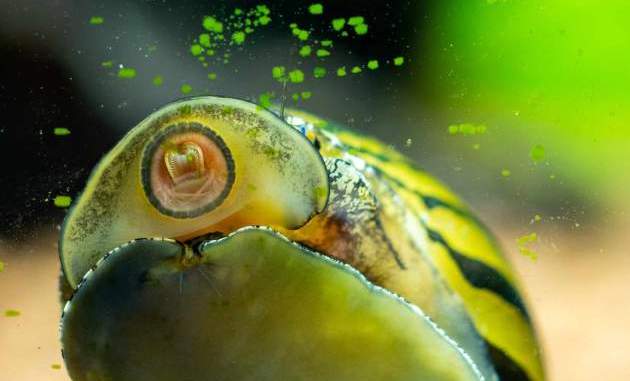
How many nerite snails do you need?
It depends on how big your tank is and the algae population. If you buy the snails for controlling algae growth, generally need 1 snail to cover 20 liters of water (5 gallons).
But if you keep them to devour many tough green coats, at least add 2 or more nerite snails for five gallons of water, depending on the tank condition. In the end, you will see the difference in your aquarium, but do not make a wish for a quick result.
Aside from nerite snails, there are a few aquarium mollusk species which has similar ability to wipe out these algae preferably, including:
- Horned nerite snail
- Theodexus snail
- Hairy snail
- Japanese trapdoor snail
- Mystery snail
- Rabbit snail
- Ramshorn snail
Phosphate Dosing Treatment
The deficiency of nutrients, primarily phosphate content, is the main issue that causes green spot algae to arise in the fish tank.
Insufficient nutrition makes the health level of the plants really poor. While they should still constantly compete with algae for food resources in the water, making their condition to be very bad.
Before you perform this treatment, check the dissolved nutrient content using your favorite aquarium test kits.
Accordingly, to resolve these alga problems from your freshwater aquarium, raising the number of phosphate substances as much as required becomes a good step to eliminate them. The suggested measure of phosphate is a range of 0.05 -1.5 mg/liter, which helps the aquatic plants well-developed and minimize algae colony.
Then, it further needs nutrient dose (especially phosphate content) to a slight excess throughout the week. Lastly, do a water change of about 50% at the end of the week.
Another way, you can straightforwardly inject potassium phosphate into the green spot algae zones inside the planted aquarium.
- Firstly, prepare the dry potassium phosphate powder (KH2PO4) and a syringe or pipette.
- Next, add some phosphate powder into the syringe/pipette and mix it with a few tank of water, then shake it.
- After that, turn off the aquarium filter.
- Apply this solution to the objects where green spot algae exist.
- Leave it works, maximum is 5 minutes, and turn the filtration system back.
Do not let the phosphate level pass through the tolerance level of your tank; it can lead to another issue. If this happens, the water’s nutrients become too high, and your plants can not absorb it all. In order to prevent this case be occurred, you should do regular water changes.
Keep in mind, if you keep a shrimptank, huge and/or often water change may cause molting issues to your crustaceans pets. Well, be careful with that.
Carbon Dioxide Treatment
It is essential to install the CO2 checker; it helps you to monitor the level of this content easily. But if you do not apply this tool, you could purchase one new carbon dioxide test kit on Amazon.
If your freshwater fish tank lacks CO2, boost this content level to a specific number by installing a carbon dioxide injection system (if you do not use a CO2 kit). Once the green spot algae population is down significantly, lessen the CO2 rate gradually till it reaches the normal level.
Does Seachem Flourish Excel Eradicate Green Spot Algae?
Some aquarium hobbyists like using a carbon liquid from the seachem brand called flourish excel to get rid of most aquarium algae types. This popular product is proven to help aquarists inhibit algae development due to its glutaraldehyde content.
Flourish excel is a famous commercial aquarium product that can supply organic carbon into the water. This can substitute the CO2 injections because the carbon content can still be used and absorbed easily by aquatic plants for photosynthesis.
Most aquarium algae can be killed with this solution such as:
- Green dust algae
- Spirogyra algae
- Rhizoclonium algae
- Oedogonium algae
- Cladophora algae
- Brown algae
- Black beard algae
- Staghorn algae
- Fuzz algae
How to use seachem flourish excel in killing the green spot algae?
Simply, you just a little bit dose of this solution directly through the syringe to the algae clusters. Use 3 to 5 ml dose of flourish excel every day until the algae are gone. This product is really safe for your fish, shrimp, and snails as well as the plants will be happier to accept more carbon content.
A different product that is a similarly powerful product with seachem flourish excel is API algaefix. Both of these cures can remedy your tropical tank from most aquatic algae that usually invade the aquarium.
Green Spot Algae Chemical Remover
Chemical removal treatment is the last method to destroy these pest. This product works for high outbreak levels and exterminates the remains that could not be scrubbed off. You can buy a hydrogen peroxide or bleach solution at nearby stores.
Perform this medication twice in certain periods, and do not forget to use gloves during the treatment. H2O2 and bleach are also helpful in disinfecting and quarantining new or old infected aquatic plants to clean them up from fungus, bacteria, algae, and other creatures that can be parasites (such as planaria, scuds, and hydra) in the planted aquarium.
To make a cleaner mixture, use 20 parts of water with 1 part of bleach liquid (20:1) in a suitable vessel, do not forget to prune the lousy component first.
- Use tweezers to soak the plants or equipment in order to avoid direct contact with your skin.
- Leave them submerged in the mixture for 5 to 15 minutes.
- Once the algae get noticeably brighter, move the plants into a container with clear water.
- Adding some water conditioner into the mixture to repeal the chlorine ruins, thereafter rinse the plants or equipment with running water until they are completely clean.
Now, we will talk about how to get rid of the green spot algae inside the aquarium:
- Use 3% hydrogen peroxide.
- Move all aquarium populations, including plants and pets, into a separate tank. Make sure to quarantine the aquatic plants to remove the green spot algae that stick to them.
- Discard the filter media from the filtration system to save the beneficial bacteria. Put it into a box or container with cycled water and oxygenate it with an air stone during the medication process.
- Add 25-35 ml of 3% hydrogen peroxide per 50 liters of water, depending on the condition.
- Pour this solution into the water surface, then stir it gently until it spreads completely. Leave it in the tank for 2 to 3 hours while the filter keeps running to maximize the treatment effect.
- Release and refill your aquarium with new fresh water at least three times to delete the remains of hydrogen peroxide and algae in the fish tank.
After performing these treatment steps, you can introduce your livestock and aquatic plants, then install back the filter media into the filtration system.
How To Prevent Your Fish Tank From Green Spot Algae Invasion
Preventing is the best practice rather than medication. Well, doing some activity that can keep away your aquascape tank from this alga is necessary, such as the following bellow:
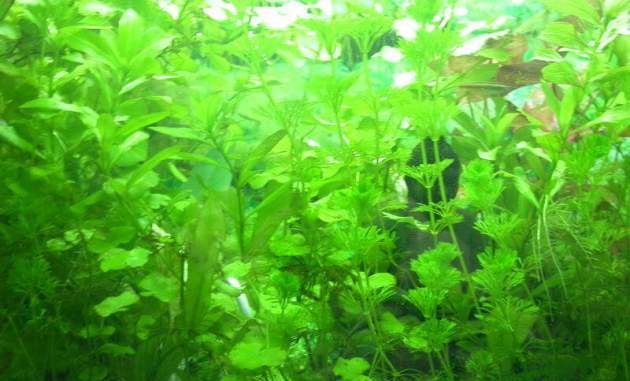
- Keep the water parameter and nutrients in the fish tank consistently stable by regularly checking it with the tester.
- Perform water change and tank maintenance on a regularly scheduled basis.
- Never overfeeding your livestock.
- Nurture some algae eaters in your fish tank to control the algae growth.
- Address the livestock and plants with health issues as quickly as possible in a different place.
- The average reasonable lighting period is 7-8 hours; a photoperiod that is less than this number can cause your aquatic plants to underperform, and the lighting time more than it may trigger other problems, such as staghorn algae and brown algae.


